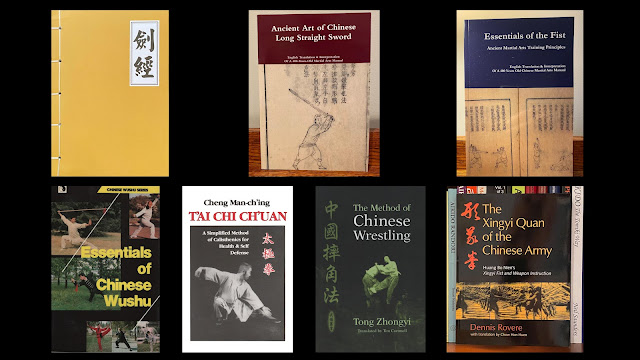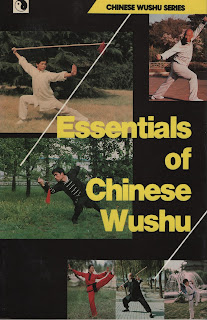March 2023 Book Survey Part 2
Welcome to the March 2023 book survey, part two. I decided to break this month's survey into three posts. The theme for this month is Kung Fu. Part one is here.
Introduction
In March 2023, I (Richard) continued my reading plan. This month I surveyed a number of books on Kung Fu.
Sword Treatise (Jian Jing), Jack Chen, Yu Da-You, c. 1565/2016
I first mentioned this book here three years ago. This title is an excerpt from a longer work by general Yu Da-You (1503/4-1579/80) titled Compilation of Vital Energy. I bought my copy of Sword Treatise or Sword Classic from the translator, Jack Chen. It's a traditionally bound paperback measuring 5 3/4 inches by 8 1/4 inches with 372 black and white pages. I love the traditional Chinese binding.
Most of the book consists of Chinese characters, Chinese romanization, and Mr. Chen's English translation. Despite the title, the book is about spear techniques. There are over 20 line drawings, all reformatted from the original.
Oddly, the great book Chinese Martial Arts Training Manuals by Kennedy and Guo only mentions this book, but does not cover it.
Ancient Art of Chinese Long Straight Sword, Jack Chen, Mao Yuan-Yi, 1621/2012/2018
I also bought this book from Mr. Chen. My copy is a paperback measuring 5 7/8 inches by 8 1/4 inches. It has 154 black and white pages. The book is a translation of the sword chapter found in the 1621 Military Preparation Manual or Wu Bei Zhi. (This is not the same as the more famous Wubeizhi referenced by karate practitioners and reviewed here and here.)
The content consists of 24 fighting stances with two hand sword plus verses.
Mr. Chen interprets the material and adds modified illustrations to show motion. I really like this content as well.
Essentials of the Fist - Ancient Martial Arts Training Principles, Jack Chen, Qi Jiguang, 1560/2012/2020
This is the third book I bought from Mr. Chen. My copy of this book is a 6 inches by 9 inches paperback with 290 black and white pages. The content is an excerpt from the 1560 book Ji Xiao Xin Shu, or New Book of Military Efficiency, by general Qi Jiguang (1528-1587/1588). The excerpt is the 14th chapter from that book, labeled the Quan Jing Jie Yao "fist manual quick important/essential," or "quick and effective way to instill the essentials of fighting skills to a warrior," or Essentials of the Fist.
This book is really amazing. It's not just 32 core principles and stances. Mr. Chen applies and integrates the principles with other arts, including historical European martial arts.
He adds illustrations from at least 20 other references. It's just outstanding work.
Be sure to check out the post Perusing Old Martial Arts Manuals for details on the contents of these three books.
Essentials of Chinese Wushu, Bin Wu & Xingdong Li, 1995
I believe I bought Essentials of Chinese Wushu while attending the World Wushu Championships in Baltimore, MD during graduate school. My copy is a paperback measuring 4 3/4 inches by 7 1/4 inches with 170 black and white pages. I was pleased to see general Qi Jiguang mentioned on page 12 and to read that Bodhidharma had no knowledge of kung fu on page 34! That was an amazing admission of reality which I was surprised to read in a Beijing-printed book.
In general, this book "recategorizes" all Chinese martial arts as "wushu." Chapter 3, for example, surveys 33 different "wushu" styles.
There is no index, and the table of contents is too brief to reveal what lies within.
The book is a neat snapshot of 1992 Chinese martial arts scholarship. You can find a PDF scan hosted at a Chinese wushu site here.
T'ai Chi Ch'uan: A Simplified Method of Calisthenics for Health & Self Defense, Cheng Man-Ch'ing, 1956/1961/1981/1993
I bought a copy of T'ai Chi Ch'uan: A Simplified Method of Calisthenics for Health & Self Defense as a reference for my own brief Tai Chi study. My copy is a paperback measuring 5 1/2 inches by 8 1/2 inches with 138 black and white pages. It contains a 1956 foreword by Cheng and a 1961 forward by Yeh. The translator is Beauson Tseng.
The book appears to be a sequel to Cheng's 1946 book Cheng's Thirteen Chapters on T'ai-chi Chuan.
Part one contains very brief "chapters," some of which are only 2 pages long. Part 2 contains the tai chi form material. There are 40 photographs with explanations, followed by some pushing hands and other exercises.
There appears to be a 1967 adaptation by Robert W. Smith on the Internet Archive.
The Method of Chinese Wrestling, Tong Zhongyi, Tim Cartmell, 1935/2005
My copy of The Method of Chinese Wrestling is a paperback measuring 6 inches by 9 inches, with 230 black and white pages. The author, Tong Zhongyi (1878-1963) was a Manchurian who learned wrestling from Cai Jintian, a Mongolian expert in Mongolian wrestling or "Guan Jiao."
This book starts with a two page introduction by the translator, Tim Cartmell. The rest is the original text. It starts with the traditional Chinese nationalistic myths about "Chen Yuanbin" taking "the arts" to Japan, which supposedly became jujutsu and judo. This part was authored by the famous Chinese historian Tang Hao (1887–1959). As I mentioned in the last post, see Annotating Wayne Muromoto's "The Legacy of Chin Gempin" for the real story.
The author's 1931 preface on page 12 states "My sincere wish is that we will overcome the insult of being called the 'sick man of Asia' and that our country will take its rightful place as an equal among nations."
Of course I thought of this famous Bruce Lee scene from Fist of Fury (1972):
This book has grainy photos but I think it's an amazing historical resource.
Academia.edu is hosting a digital copy.
The Xingyi Quan of the Chinese Army: Huang Bo Nien's Xingyi Fist and Weapon Instruction, Dennis Rovere, Chow Hon Huen, Huang Bo Nien, 2008
My copy of The Xingyi Quan of the Chinese Army is a paperback measuring 7 inches by 9 1/4 inches with 144 black and white pages. The core text is Xingyi Fist and Weapon Instruction by Huang Bo Nien, written in 1928. The late Brian Kennedy endorsed this text, which carries more weight than the controversy I read online.
This is a really great reproduction of the original rough photos. However, the author recreates the photos with a training partner.
After the theory section, I had a hard time discerning what constituted the original text, and what constituted Mr. Rovere's commentary. This is still a cool book though.
Conclusion
Anyone who wants to get at the heart of verifiable Chinese martial arts sources should purchase all three of Mr. Chen's titles. I keep a close watch on his Chinese Long Sword Facebook page for signs of new texts.
You may know about our Amazon Wish List. If you would like to help us get books to read and review from that list, then please consider supporting us via Buy Me a Coffee.
If you like this article, check out our Facebook page, Instagram account, Twitter feed, and Amazon Wish List. Be devoted!





















Comments
Post a Comment